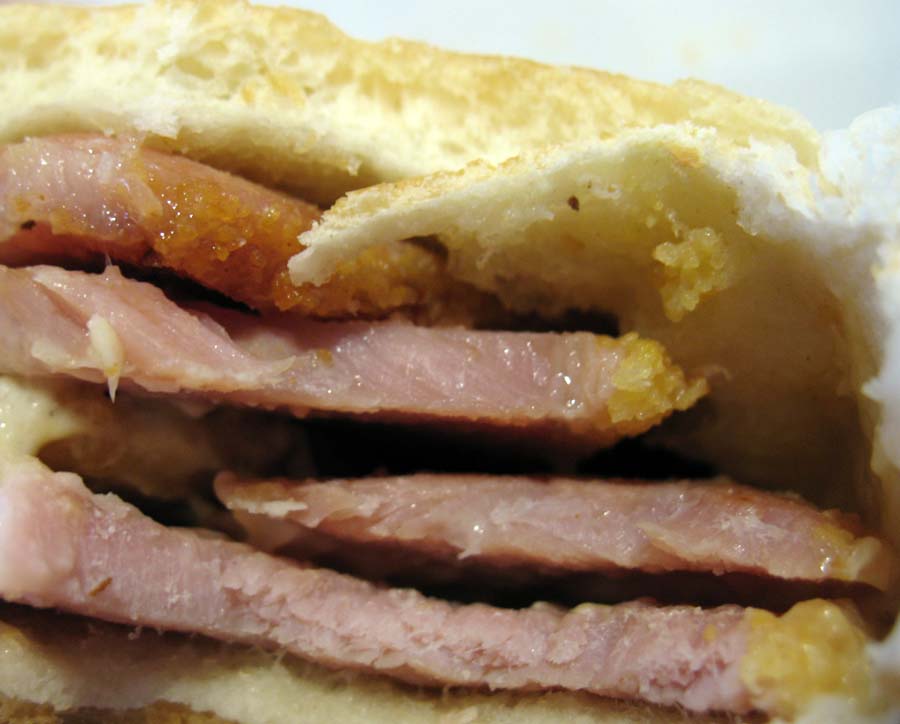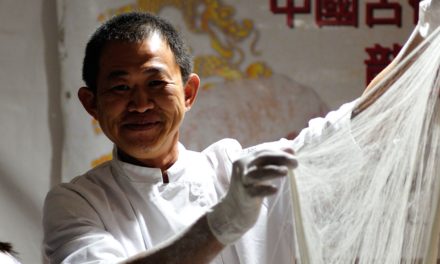Toronto’s Original
Foodie Claim
(The Salty One)
Photo by Flickr user John Vetterli (CC-BY-SA-2.0)
by Evelyn Reid
Originally published on About.com December 27, 2011
Google “Toronto food” on any given day and it won’t take long to stumble on online diatribe dissing Hogtown over lacking its own signature dish, which I found hard to believe.
Most, if not all major cities lay claim to something. Rome boasts pasta carbonara, one dish among a long list of regional creations. Across the pond in Philadelphia, it’s cheese steaks. And north of the American border, Montreal prides in its smoked meat and one-of-a-kind bagels. But what about Toronto? There must be something uniquely native to the Big Smoke, no?
It’s Called Bacon
English immigrant William Davies, a meat shop owner specializing in cured pork, created peameal bacon on Toronto soil circa 1875 at the St. Lawrence Market. But it’s not just any old slab of pig belly fat. If anything, this cut involves next to no fat all.

Left: roasted peameal bacon with a maple glaze as sold by Witteveen Meats at the St. Lawrence Market in Toronto, Ontario, Canada.
Photo by Flickr user snowpea&bokchoi (CC BY-SA 2.0)
What Is Peameal Bacon?
Davies’ original formulation features slow-cured Canadian bacon—back bacon—cooked with a brine of crushed yellow peas rolled on the outsides of a given slab. Contrary to the commercially popular (and fatty) side or strip bacon, which is basically pork belly, back bacon is a low-fat, ham-like textured meat cut from the eye of pork loin, which located in the middle of a pig’s lower back.
Incidentally, Davies went on to become the biggest pork producer in the British Commonwealth. According to “world famous” peameal bacon sandwich-making Carousel Bakery co-owner Robert Biancolin, Davies is the reason Toronto is nicknamed Hogtown in the first place.
“According to “world famous” peameal bacon sandwich-making Carousel Bakery co-owner Robert Biancolin, Davies’ savory creation is the reason Toronto is nicknamed Hogtown.”

Left: peameal bacon sandwich innards.
Photo by Flickr user Michael Newman (CC BY-SA 2.0)
The Peameal Bacon Sandwich
Initiates to the peameal bacon experience are well-advised to sample the protein in a sandwich. Depending on who’s making it, slices might be thin. Or thick. They could be served in a bun. Or squished into a panino with cheese, onions, lettuce and tomato slathered with mayo. Or mustard. Or nothing at all.
In my case, I had Carousel Bakery’s “world famous” peameal bacon sandwich without any fixings, just thick slices in a freshly-baked bun and a side of ”amazing maple” sauce combining old-style mustard, maple syrup, and horseradish. Salty, pungent, and sweet.
Purists advise peameal bacon sandwich virgins first experience it without any mustard and though I enjoyed the moist, juicy, condiment-free first bites, my taste buds yearned for mustard’s sharp kick, with maple sweetening the palate and horseradish shooting through the nose, a Hogtown food legend elevated.
Toronto’s Original Foodie Claim
(The Salty One)
by Evelyn Reid
Originally published on About.com December 27, 2011

Photo by Flickr user John Vetterli (CC-BY-SA-2.0)
Google “Toronto food” on any given day and it won’t take long to stumble on online diatribe dissing Hogtown over lacking its own signature dish, which I found hard to believe.
Most, if not all major cities lay claim to something. Rome boasts pasta carbonara, one dish among a long list of regional creations. Across the pond in Philadelphia, it’s cheese steaks. And north of the American border, Montreal prides in its smoked meat and one-of-a-kind bagels. But what about Toronto? There must be something uniquely native to the Big Smoke, no?
It’s Called Bacon
English immigrant William Davies, a meat shop owner specializing in cured pork, created peameal bacon on Toronto soil circa 1875 at the St. Lawrence Market. But it’s not just any old slab of pig belly fat. If anything, this cut involves next to no fat all.

Above: roasted peameal bacon with a maple glaze as sold by Witteveen Meats at the St. Lawrence Market in Toronto, Ontario, Canada (photo by Flickr user snowpea&bokchoi (CC BY-SA 2.0)).
What Is Peameal Bacon?
Davies’ original formulation features slow-cured Canadian bacon—back bacon—cooked with a brine of crushed yellow peas rolled on the outsides of a given slab. Contrary to the commercially popular (and fatty) side or strip bacon, which is basically pork belly, back bacon is a low-fat, ham-like textured meat cut from the eye of pork loin, which located in the middle of a pig’s lower back.
Incidentally, Davies went on to become the biggest pork producer in the British Commonwealth. According to “world famous” peameal bacon sandwich-making Carousel Bakery co-owner Robert Biancolin, Davies is the reason Toronto is nicknamed Hogtown in the first place.

Above: peameal bacon sandwich innards (photo by Flickr user Michael Newman (CC BY-SA 2.0))
The Peameal Bacon Sandwich
Initiates to the peameal bacon experience are well-advised to sample the protein in a sandwich. Depending on who’s making it, slices might be thin. Or thick. They could be served in a bun. Or squished into a panino with cheese, onions, lettuce and tomato slathered with mayo. Or mustard. Or nothing at all.
In my case, I had Carousel Bakery’s “world famous” peameal bacon sandwich without any fixings, just thick slices in a freshly-baked bun and a side of ”amazing maple” sauce combining old-style mustard, maple syrup, and horseradish. Salty, pungent, and sweet.
Purists advise peameal bacon sandwich virgins first experience it without any mustard and though I enjoyed the moist, juicy, condiment-free first bites, my taste buds yearned for mustard’s sharp kick, with maple sweetening the palate and horseradish shooting through the nose, a Hogtown food legend elevated.




